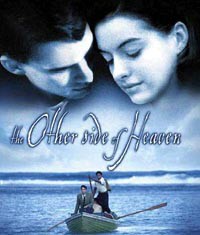|
The Other Side of Heaven
Click here to go to the official site.
 The Other Side of Heaven is based on a true story that takes place in the 1950's, and is dimly reminiscent of the book Peace Child by Christian missionary, Don Richardson. The story is about a young man, John Groberg, played by Christopher Gorham, who departs for the remote island of Tonga after being called by God from the Mormon Church to serve his two-year mission. Leaving his sweetheart, Jean Sabin, played by Anne Hathaway from The Princes Diaries, he departs for what is to him an unknown land to convert the people of Tonga to Mormonism. The Other Side of Heaven is based on a true story that takes place in the 1950's, and is dimly reminiscent of the book Peace Child by Christian missionary, Don Richardson. The story is about a young man, John Groberg, played by Christopher Gorham, who departs for the remote island of Tonga after being called by God from the Mormon Church to serve his two-year mission. Leaving his sweetheart, Jean Sabin, played by Anne Hathaway from The Princes Diaries, he departs for what is to him an unknown land to convert the people of Tonga to Mormonism.
The movie opens with John playing his trumpet in a vivacious dance scene at BYU back in 1953. The obvious jealousy that John has for Jean is first presented where he jumps down from the bandstand and cuts into the dance between Jean and some other guy. John makes it clear to Jean that he plans on marrying her for all "time and eternity." There are other but more subtle hints like this throughout the movie that makes the Christian viewer want to gag over its over zealous approach to making eternal marriage good, desirable, and most of all, true. The movie even slips in a subtle denial that the Church isn't associated with polygamy anymore when John, after being offered many women, tells a tribesman that one woman was good enough for him.
Well, John gets sent to Tonga for two years to convert souls and "build up the kingdom of God." On the journey to the small island he is confronted with numerous difficulties many of which are more humorous than tragic to the viewer. John arrives on the island with his companion Feki (Joe Folau) wearing a white shirt and plain dark tie. The short-sleeve dress shirt and the dark tie were their daily attire, which must have looked very odd to the native Tongans who wear grass skirts and bare backs. Wearing these foreign clothes in Tonga made it clear that Mormonism is truly a western religion, and that America is its progenitor. It was an overwhelming element in the story that left the viewer baffled and slightly upset at the Church's ineptness to the Tongan way of living. In the Bible, Paul said that he attempted to become all things to all people that he might by all means save some (1 Corinthians 9:22).
After arriving on the island, John notices the presence of a Christian minister, and his followers intermingled with those of whom John is trying to reach. The minister is portrayed as somewhat of a witch doctor-type with dark clothes and long beard. It seems evident that there was a point of contrast with the Mormons wearing all white, the propagators of the truth, and the Christian minister wearing black who had little faith. It was an obvious demonstration that the LDS Church was the greater of the two. It is interesting to note, however, that the Christian minister was on the island first and that the LDS Church was most likely feeding off of his converts instead of starting their own indigenous ministry.
In his efforts to convert the people, he begins to learn the Tongan language. After adequately learning the language, he went from house to house to teach what he called "God's plan of happiness" and "eternal love." Though it is known to the viewer that John was spreading a supposed message of "happiness" and "love," the viewer was completely bewildered as to the content of those messages. It was quite remarkable that a movie about a missionary's work didn't even provide the gospel to the audience that John was preaching. This was a key element that was missing in the movie, and it made the film into something of a jaded picture with no convicting power.
Throughout his missionary life in Tonga, there were a few challenges that made his stay difficult. There was a large hurricane that destroyed the island and left them foodless, rats ate the bottoms of his feet, he witnessed his friend die, a girl tempted him by taking off her clothes in front of him, and he missed his sweetheart tremendously. John also had a few triumphant periods as well. He baptized many people, and set up more wards than he first envisioned. But the most notable victory was when he "helped God heal a little boy" who fell out of a mango tree. I'm sure God was grateful to have John's help.
After his missionary work was finished, John was eventually called back to the U.S. When he arrived home, his girl was there to meet him. As all sappy romantic movies end, John and his sweetheart were married and lived happily ever after... for eternity, I suppose.
More than anything, this movie is a sappy love story that happens to revolve around John's mission in Tonga. I didn't find the exploration of his mission very riveting, nor did I find the dynamics between him and his sweetheart very moving.
Finally, for more reviews and information on The Other Side of Heaven, click here.
Matt
PerfectRighteousness.com
March 15, 2004
|